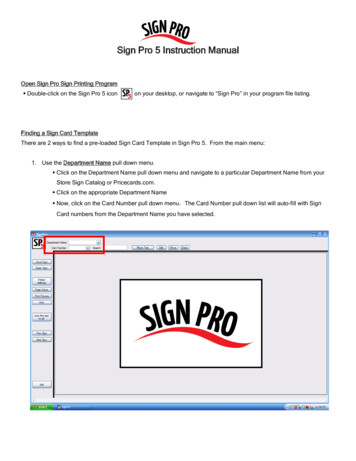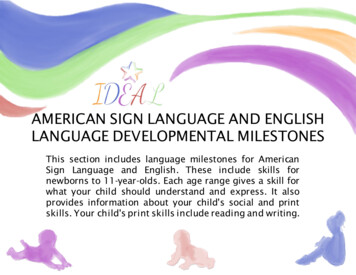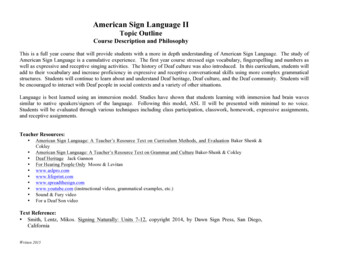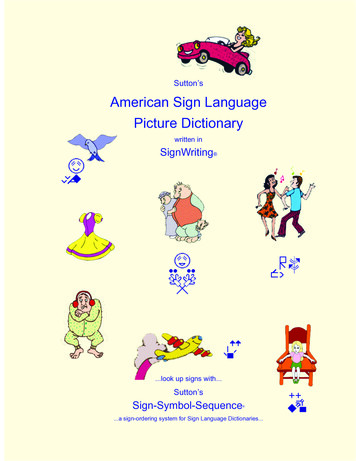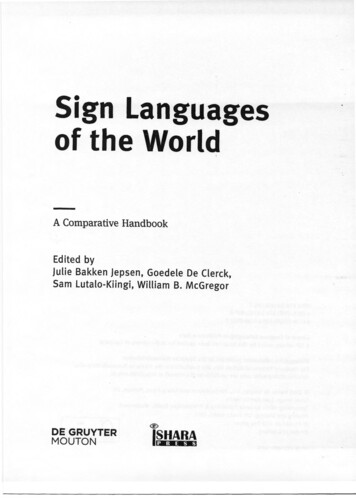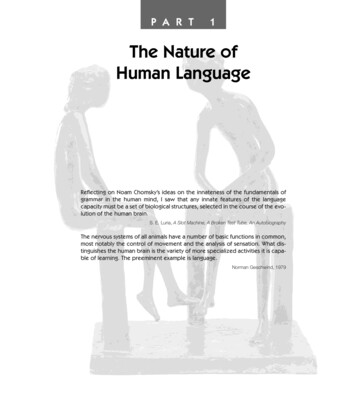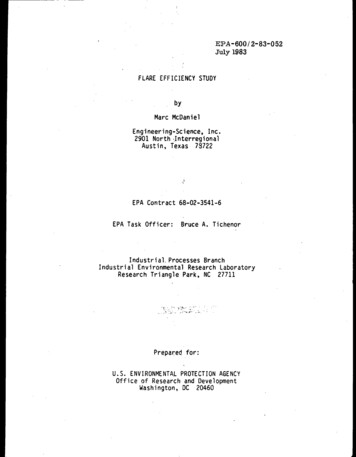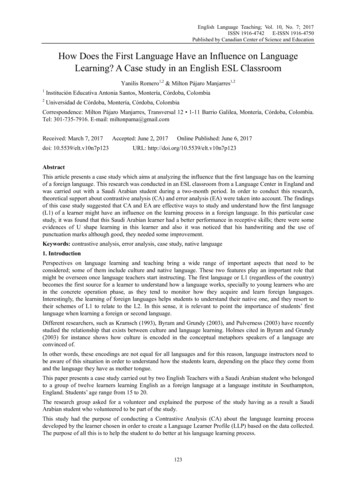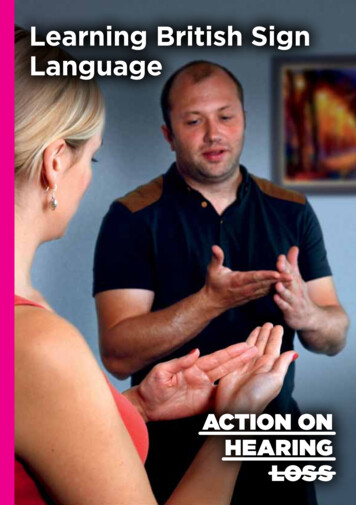
Transcription
Learning British SignLanguage
My parents use sign languageand they taught me as a baby.It’s such an expressive andimpressive language thatutilises not just your handsbut body language and facialexpressions too. When peoplesee that I can use sign language,they also want to learn it – andthose who do learn fall in lovewith it just like I did.Andrew PalmerIn this leaflet we explain what British Sign Language isand how to learn it. If you have any questions, our friendlyhelpline team is waiting to answer your call or email.TelephoneTextphoneSMS0808 808 01230808 808 90000780 000 0360(standard text message rates apply)Email information@hearingloss.org.uk
Learning British Sign LanguageAre you thinking about learningBritish Sign Language (BSL)?Read this leaflet to find out: what BSL is and how you can learn it how people who are deaf communicate about sign language in different countriesand regional variations in BSL some essential BSL signs used in everydaylife, and the fingerspelling alphabet.The photographs in this leaflet will introduce you to BSL. They aretaken from our Start to Sign! book, which contains photographsof more than 800 signs to support your learning. Buying the bookalso gives you free access to see the moving signs online, and youcan test yourself with our interactive quizzes.See page 19 for more information.What is BSL?People who are deaf use various methods of communication,including speech and lipreading, but BSL is the most widely usedmethod of signed communication in the UK. Some people useSign Supported English (SSE), which is not a language in its ownright, but more a type of English with signs.It’s hard to say how many people in the UK use BSL as their firstor preferred language. Estimates vary from 50,000 to 70,000.www.actiononhearingloss.org.uk3
Learning British Sign LanguageWhat kind of language is BSL?BSL has evolved naturally, as all languages do. It uses acombination of hand shapes and movements, lip patterns,facial expressions and shoulder movements.BSL is structured in a completely different way to English.In BSL you start with the main subject or topic. After that,you refer to something about the topic.For example:English – ‘What is your name?’BSL – ‘Name – what?’NameWhatLip patternsLip patterns are a very important part of BSL. The signs for‘uncle’, ‘aunt’, ‘nephew’ and ‘niece’ illustrate this (see oppositepage). The handshape and movement are the same for thesefour signs, but the lip pattern is different.4
Learning British Sign LanguageUncleAuntNephewNieceHow can I learn BSL?It is very difficult to learn to sign from a leaflet, book, video orCD-ROM alone. The best way to learn BSL is to take a coursetaught by a qualified sign language teacher.Our experienced trainers can come to where you work to teach anintroductory Start to Sign course. Contact our helpline (see backcover) about this and for details of BSL courses near you.www.actiononhearingloss.org.uk5
Learning British Sign LanguageIs sign language the same around the world?No, sign languages are as varied as spoken languages. Differentcountries have their own unique sign language, but some signlanguages do have a similar structure. BSL is only used in the UK.In Northern Ireland, people who are deaf like to use Irish SignLanguage (ISL) and BSL.Is BSL the same across the country?No, there are regional variations in sign language, just as thereare in spoken languages. In different parts of the country, signswill have different meanings, or there will be different signsfor one word. For example, there are 10 to 12 variations forthe word ‘holiday’.What is fingerspelling?Fingerspelling is the BSL alphabet. Certain words – usuallynames of people and places – are spelled out on fingers.However, fingerspelling alone is not sign language.See opposite for the fingerspelling alphabet.We have cards, bookmarks and posters of the fingerspellingalphabet (sometimes called the manual alphabet). We also havecards of the Welsh, Irish and deafblind fingerspelling alphabets.See page 19 for further details.6
Learning British Sign LanguageFingerspelling ingloss.org.uk7
Learning British Sign LanguageGreetingsHelloPleaseThank youSorry8Goodbye
Learning British Sign LanguageGreetingsHow are you?QuestionsQuestionAsk (directional verb)WhoWhatwww.actiononhearingloss.org.uk9
Learning British Sign ke10Dislike
Learning British Sign /Wifewww.actiononhearingloss.org.uk 11
Learning British Sign LanguageFamilyMotherFatherBrotherSisterFood and drinkSandwich12Fruit
Learning British Sign LanguageFood and ringloss.org.uk 13
Learning British Sign LanguageTimeMorningNightToday14
British Sign iononhearingloss.org.uk 15
Learning British Sign LanguageWorkTextphoneEmailComputer16Telephone
Want to get involved?We work for a world wherehearing loss doesn’t limit or labelpeople, where tinnitus is silenced,and where people value and lookafter their hearing.But we can’t do this alone.We need your help to raisevital funds and awareness.Have fun and fundraiseThere are lots of fun ways you can get involved and make areal difference to the lives of the 10 million people in the UKwho have some form of hearing loss. Whether you want tocycle to Paris, run a marathon, jump out of a plane or stick tocake bakes and collections, we have an event for you.And if you’d like to organise an event in your own community,we can offer ideas and plenty of materials.Find out more about how you can get involved visit www.actiononhearingloss.org.uk/fundraise call or text our Events Team on 0845 634 0687 email events@hearingloss.org.uk write to:Action on Hearing Loss19-23 Featherstone StreetLondon EC1Y 8SL
Please send meinformation about:(tick relevant boxes) your programme of fundraising events how I could help to raise money in my local communityTitle (Mr/Mrs/Ms/Miss)First ignaturePlease return this form to:Action on Hearing LossFREEPOST NAT21395London EC1B 1BRPlease tick here if you would like to receive emails from us includingyour membership email every two months.Occasionally, we may want to let you know about the work we are doing.If you would prefer not to be contacted in this way, please tick this box. Occasionally, we will allow other organisations to contact you,but if you would prefer not to be contacted, please tick this box.If you are happy for us to contact you by phone or by email tick this box.A0568
British Sign LanguageWhere can I get further information?If you want to find out more about hearing loss or tinnitus,our leaflets are the perfect place to start. And if you’re lookingfor more detailed information, we have a wide range of factsheetscovering everything you need to know.You might also find some of our other publications useful: Fingerspelling alphabet(bookmark, card or poster)llingFingerspealphabet Irish fingerspelling alphabet (card) Welsh fingerspelling alphabet(card) Deafblind fingerspelling alphabet(card)Please contact our helpline (see backcover) for free copies of these. And let usknow if you’d like any of our factsheetsand leaflets – including this one – inBraille, large print or audio format.MSNow test yourself!These photoswill help yousomeone wholearn to understanis fingerspedlling to you.NTUYLKQPOFEJIHGDCBAVWRXZWhat is fingerspelling?Fingerspellingis the BritishIt’s used tospell out words Sign Language (BSL)But remembealphabet.like namesr: fingerspeof people andlling aloneplaces.is not signlanguage.How do youfingerspell?Learn the 26different fingerof the alphabet.positionsfixed position. With 24 of the letters, that make the lettersshow the shapeOnly with ‘H’ and ‘J’ do your hands stay in ayour fingersof the letters.move toThe best wayto learn fingerspewith someonewith a hearing lling and BSL is bycourses inpractisingloss. Contactyour area (seeus for detailsback page).ofYou can also download our leaflets and factsheets for free atwww.actiononhearingloss.org.uk/factsheetsStart to Sign! is our British Sign Language (BSL) support bookfor beginners with free online access to BSL video clips. Itcontains colour photographs of more than 800 signs, plus lots ofinformation on the development, structure and grammar of BSL.To order, contact us on 01733 361199 (telephone), 01733 238020(textphone), email solutions@hearingloss.org.uk or shop online lished: September 2012. Review date: September 2013.We welcome your feedback – please email oss.org.uk 19
We’re the charity taking action onhearing loss since 1911. We can’t dothis without your help.To find out more about what we doand how you can support us go towww.actiononhearingloss.org.ukTelephone 0808 808 0123Textphone 0808 808 9000SMS0780 000 0360(standard text message rates apply)Email information@hearingloss.org.ukAction on Hearing Loss is the trading name ofThe Royal National Institute for Deaf People.A registered charity in England and Wales(207720) and Scotland (SC038926) A0568/0912
Learning British Sign Language www.actiononhearingloss.org.uk Nephew Aunt Niece Uncle How can I learn BSL? It is very difficult to learn to sign from a leaflet, book, video or CD-ROM alone. The best way to learn BSL is to take a course taug
